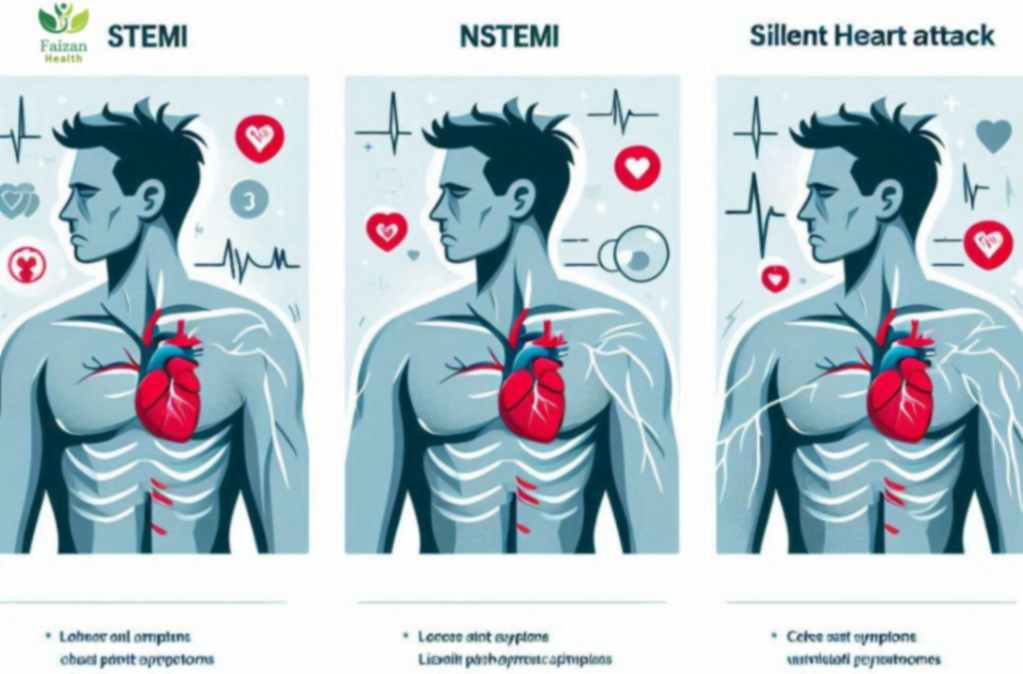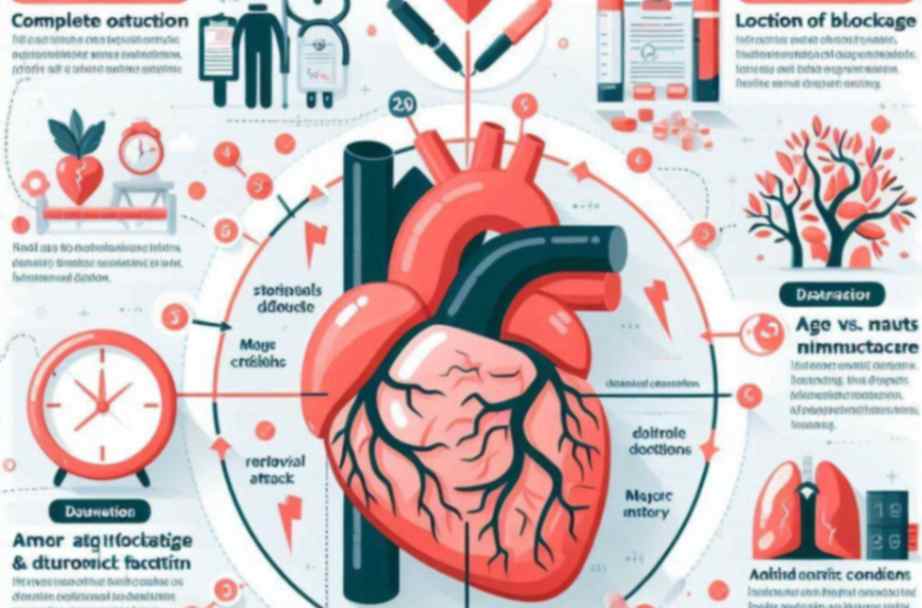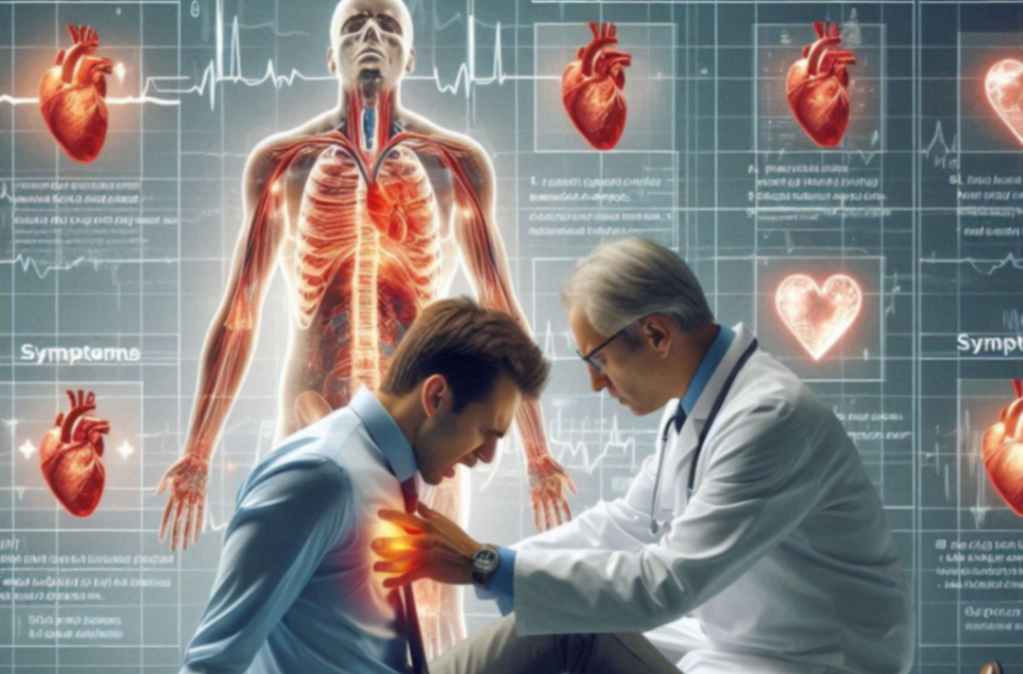A heart attack can strike without warning, and every second counts. Imagine a chest pain that won’t go away, a pain that radiates to your arm or neck. It’s a scary experience, but knowing how long a heart attack can last and recognizing the signs can save your life.
This article dives into the duration and symptoms of a heart attack, giving you the knowledge to act fast. Whether it’s a sharp pain that lasts for minutes or a subtle discomfort that lasts for hours, it’s important to understand these signals
1: What is a heart attack?
A heart attack, also known as a myocardial infarction, occurs when blood flow to a part of the heart stops. This blockage prevents oxygen from reaching the heart muscle, causing damage or even death to the affected area. The longer the blockage persists, the more severe the damage to the heart. This is why immediate medical attention is essential when a heart attack occurs.
Causes of Heart Attack:
The most common cause of heart attack is the buildup of fatty deposits, called plaque, in the coronary arteries. These arteries supply blood to the heart. Over time, these plaques can harden or rupture, causing blood clots to form. If the clot is large enough, it can completely block blood flow to the heart muscle, leading to a heart attack.

Risk factors:
Certain factors increase the risk of heart attack. Some of these, like age or family history, are beyond your control. The risk of heart attack increases with age, especially after age 45 for men and 55 for women. If close family members have had a heart attack, your risk is even higher.
However, many risk factors can be managed through lifestyle choices!
- Smoking.
- High blood pressure.
- High cholesterol.
- Obesity.
- Sedentary lifestyle.
All contribute to the likelihood of a heart attack. Managing stress and eating a balanced diet can significantly reduce your risk. Controlling diabetes, if you have it, is also important to prevent heart attacks.
2: How long can a heart attack last?
The duration of a heart attack can vary, depending on the individual and the severity of the event. Understanding the different stages of a heart attack—from early symptoms to the recovery process—can help you recognize when something is wrong and when to seek immediate medical help.
Early Symptoms:
A heart attack often starts with subtle signs that can be easy to dismiss. These early symptoms may begin hours or even days before the actual heart attack. You may experience mild chest pain, fatigue, or shortness of breath. These early warning signs are known as the prodromal phase, and although they may not be severe, they should never be ignored.

Duration of Symptoms:
The most severe part of a heart attack is the acute phase, where symptoms become severe and vague. This phase can last anywhere from a few minutes to several hours. During this time, you may feel pain, pressure, or tightness in the chest, which often spreads to your arm, neck, or jaw.
Other symptoms may include sweating, nausea, and a sense of impending doom. The duration and severity of these symptoms can vary, but they usually do not go away with rest.
It is important to note that the longer these symptoms last, the greater the damage to the heart muscle. Immediate medical intervention is essential. Some damage can be minimized if treated promptly, which is why it’s so important to recognize and respond to these symptoms right away.
Post-Attack (Recovery Phase):
After the acute phase of a heart attack, there is a recovery period where the heart begins to heal. The length of this phase can vary widely depending on the extent of the damage and how quickly it is treated. Some symptoms, such as fatigue or mild chest pain, may last several days or weeks as the heart repairs itself. During this time, ongoing medical care and lifestyle changes are important to help prevent further heart problems.
3: Types of Heart Attacks and their Duration:
Heart attacks come in many forms, each with different levels of intensity and duration. Understanding these types can help you understand how they differ in symptoms and outcomes. The three main types are STEMI, NSTEMI, and silent heart attacks.
STEMI (ST-Elevation Myocardial Infarction):
STEMI is the most severe type of heart attack. It occurs when a large artery that supplies blood to the heart is completely blocked. The term “ST-Elevation” refers to a characteristic pattern seen on an electrocardiogram (ECG) during a heart attack, indicating significant damage to the heart muscle.
Symptoms of STEMI are often severe and sudden, with severe chest pain, shortness of breath, and other classic symptoms of a heart attack. The acute phase of STEMI can last for several hours, during which considerable heart muscle damage occurs.
Prompt medical intervention, such as angioplasty or clot-busting drugs, is important to restore blood flow and minimize damage. Without prompt treatment, STEMI can lead to permanent heart damage or death.

NSTEMI (Non-ST-Elevation Myocardial Infarction):
NSTEMI is a less severe type of heart attack than STEMI, but it is still a medical emergency. In NSTEMI, the coronary artery is only partially blocked, so the heart continues to receive some blood flow, although it is insufficient. Unlike STEMI, the ECG does not show an ST-elevation pattern, making early diagnosis difficult.
Symptoms of NSTEMI may be similar to STEMI, but may be less severe. NSTEMI can last for several hours, with symptoms that may come and go. Because the blockage is not complete, the damage to the heart muscle may be less severe, but it can still lead to significant complications if left untreated. Early medical intervention is essential to prevent partial obstruction from worsening.
Silent Heart Attack:
A silent heart attack is one without the typical symptoms of a heart attack, such as severe chest pain. Instead, symptoms may be so mild or unusual that they are mistaken for other conditions such as indigestion or fatigue. Some people may not realize they are having a heart attack until tests detect heart damage.
The duration of a silent heart attack can vary widely, as symptoms often go unnoticed or ignored. Although the immediate effect may seem minor, silent heart attacks can cause lasting damage to the heart, increasing the risk of heart problems in the future. Because they’re easy to miss, it’s important to be aware of any unusual symptoms and seek medical advice if something feels off, especially if you’re at risk for heart disease.
4: Factors affecting the duration of a Heart Attack:
The duration of a heart attack depends on several important factors. These include how severe the obstruction is, where it is located, and the individual’s overall health. Each of these factors plays a role in how long a heart attack lasts and how severe it is.
Severity of Obstruction:
The severity of the blockage in the artery is an important factor in determining how long a heart attack lasts. A complete blockage, such as in a STEMI, usually results in a longer and more damaging heart attack because it cuts off the blood supply to a large area of the heart muscle.
On the other hand, a partial blockage, as seen in NSTEMI, can cause a heart attack, but it still carries significant risks. The more severe the obstruction, the more urgent it is to seek treatment.
Location of Blockage:
The location of the blockage also affects the duration and effect of the heart attack. If the blockage is in a large artery that supplies a lot of blood to the heart, the attack may be more severe and last longer. This leads to more damage and a longer recovery period. However, even small artery blockages can cause serious problems and require immediate medical attention.

Individual health factors:
A person’s overall health and medical history also affect how long a heart attack lasts. Older adults or people with chronic conditions such as diabetes or high blood pressure may have longer and more severe heart attacks. Poor lifestyle habits, such as smoking or lack of exercise, can also make a heart attack worse. On the other hand, people who are generally healthy may have shorter and less severe heart attacks, although they are still at risk.
Time for Medical Intervention:
How quickly someone gets medical help is important in determining the length and outcome of a heart attack. Prompt treatment, such as anticoagulation or angioplasty, can significantly shorten the duration of a heart attack and limit damage. Delaying treatment can lead to a longer and more severe heart attack, increasing the risk of complications.
5: Recognize the symptoms and seek immediate Help:
Recognizing the symptoms of a heart attack and taking immediate action can save lives. Heart attack symptoms can vary from person to person, but knowing the key signs can help ensure you get help when you need it most. Some symptoms are common and well-known, while others may be less obvious.
Common symptoms:
Chest pain or discomfort is the most recognizable symptom of a heart attack. This pain often feels like pressure or squeezing in the chest and can last for several minutes. It can also come and go. The pain may spread to other parts of the body, such as the arms, neck, jaw, or back, signaling that something serious is going on.
Along with chest pain, shortness of breath is another common symptom. You may find it difficult to breathe, whether you are active or at rest. Many people experience sweating, nausea, or light-headedness during a heart attack.

Abnormal Symptoms:
Heart attacks don’t always present with classic symptoms. Women, older adults, and people with diabetes are more likely to have abnormal symptoms. These can include upper back pain, jaw discomfort, or even a feeling of extreme fatigue or restlessness. Sometimes, the symptoms are so mild or unusual that they are mistaken for something less serious, such as indigestion or stress. These unusual symptoms can delay getting help, which is why it’s important to consider a heart attack even if the symptoms aren’t typical.
When to Seek Help:
If you experience symptoms that may be related to a heart attack, it is important to seek medical help immediately. Don’t wait to see if the symptoms go away on their own. Every minute counts to reduce heart damage. call emergency services immediately; They can start treatment on the way to the hospital. Even if you’re not sure if it’s a heart attack, it’s best to be careful and seek medical attention.
Read More About 6 Signs of Heart Attack a Month Before.
Conclusion:
A heart attack can strike without warning, and every second counts. Whether it’s sharp, persistent chest pain or subtle symptoms that last longer, knowing how long a heart attack can last and recognizing the symptoms can be critical to survival. From the early symptoms before a heart attack to the acute phase where time is of the essence, being aware of the duration and types of heart attacks can help you act faster.
The key is to not ignore any symptoms, whether they are classic or unusual, and seek immediate medical help if you suspect a heart attack. By acting quickly and understanding these important aspects, you can greatly improve your chances of a positive outcome and prevent serious damage.
FAQs:
How long can a Heart Attack last?
The duration of a heart attack varies. The acute phase usually lasts from a few minutes to several hours. Initial symptoms may appear a few days earlier, while recovery may take weeks, depending on the severity and speed of treatment.
What should I do if I suspect a Heart Attack?
Get emergency medical help immediately if you suspect a heart attack. Do not wait for symptoms to subside. Prompt treatment is essential to minimize damage to the heart and improve the chances of recovery. Call emergency services and get to the hospital.



